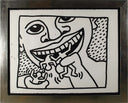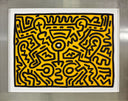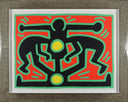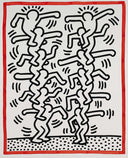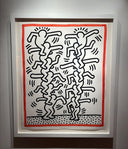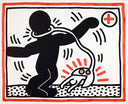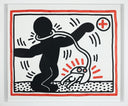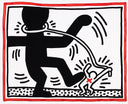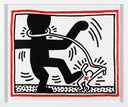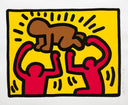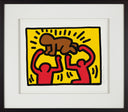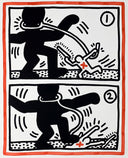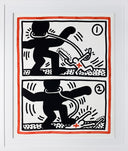Untitled (Cannibal), 1982
Details
Year: 1982
Sheet size: 38 x 50"
Image size: 38 x 50"
Framed size: 47 x 59"
Signature: signed and dated 'SEPT.21 - 82 + K. Haring' on verso
About the Work
"Untitled (Cannibal)" is a sumi ink on paper created by Keith Haring in 1982. The artwork is signed and dated verso 'SEPT.21 - 82 + K. Haring'. The image size is 38 x 50" and the artwork is framed in a custom, closed-corner, gold-leaf frame. The artwork ships framed.
By the early 1980s, Haring had begun to move beyond his famous subway drawings, creating large-scale works that confronted the anxieties of modern life with an unprecedented combination of immediacy and mythic force.
Executed on September 21, 1982, this monumental sumi ink drawing — colloquially titled "Cannibal" — is a powerful example of Haring’s early mastery, a time when his language of bold lines and simplified figures achieved both graphic clarity and psychological depth.
Created in deep black sumi ink on a commanding sheet measuring 38.5 x 50 inches, the work depicts a single monumental face, its mouth stretched open in a consuming frenzy. From the upper left corner, this voracious figure lunges diagonally across the composition, its enormous jaws devouring smaller human forms. One victim is already halfway inside the mouth, while two more are held aloft — one with its head moments from being bitten off. The creature’s eyes are rendered as vacant voids, imparting an eerie, deadened expression that heightens the sense of nightmare inevitability. The power of this image lies in the tension between Haring’s instantly legible vocabulary — thick lines, simplified anatomy — and the disturbing violence of the scene. This duality is at the heart of Haring’s most compelling work: symbols that read as almost childlike, yet carry the weight of profound existential dread.
1982 was a formative year for Haring. Having recently debuted at Tony Shafrazi Gallery and established his presence in New York’s downtown art scene, he was also grappling with the growing specter of the AIDS epidemic, the pervasiveness of media consumption, and the dehumanizing forces of political and economic systems. The subject matter of "Cannibal" resonates with multiple layers of reference. As classical allegory, it recalls Saturn devouring his children — a timeless symbol of power destroying innocence. As Dantean Vision it evokes the medieval depictions of Satan in 'Inferno' chewing the arch-traitors — Cassius, Judas, and Brutus — and suggests an eternal punishment meted out by a monstrous authority. As Kafkaesque anxiety, this dehumanized face and deadened eyes evoke a mechanistic appetite, a bureaucratic horror where the individual is consumed without meaning. And finally, as a Boschian nightmare, it echoes Hieronymus Bosch’s apocalyptic scenes, transforming the familiar into something uncanny and grotesque. This combination of mythic archetype and contemporary unease is what makes the work so powerful. It is not merely a depiction of violence but a reflection on the devouring structures — political, cultural, biological — that defined Haring’s generation.
This imagery bridges ancient allegory and modern anxiety in a way that situates it among the most significant social commentaries of Haring’s oeuvre. While many of Haring’s most iconic images celebrate joy and collective energy, "Cannibal" demonstrates his equally powerful capacity to evoke dread and moral critique — qualities that deepen any serious collection of contemporary art. 1982 marks the moment when Haring’s work transitioned from underground phenomenon to global conversation, resonating with the fears and contradictions of an era grappling with disease, surveillance, and violence. "Untitled (Cannibal)" is a profound statement on power and vulnerability — one that continues to speak with unsettling force to our own time.
About the Artist

Untitled (Cannibal), 1982
MORE FROM THIS ARTIST
Start your collection with guidance you can trust
For nearly 50 years, we’ve helped new collectors find artwork they love and understand the stories behind each piece. Our gallery consultants offer personalized guidance, whether you’re exploring originals, limited editions, or discovering an artist for the first time. Visit your nearest gallery to start collecting with confidence.


Frequently Asked Questions
Your artwork comes with a Certificate of Authenticity (or Letter of Authenticity), professional packaging, and insured delivery.
We ship fully insured, using trusted carriers. Each piece is professionally packed to ensure safe arrival. Shipping times vary based on the location of the art, its destination, and whether or not it is framed (ready to ship) at the time of your purchase.
All our works come beautifully framed. Some print multiples may have framing options if we have unframed editions available in our warehouse. Our in-house framing provides high-quality moulding, acid-free materials and either UV plexiglass or framer’s grade acrylic. High value works may be framed in custom, closed-corner frames, and are often framed in Optium museum glass for enhanced clarity.
No, Martin Lawrence Galleries does not provide appraisal services. To ensure that appraisals are fully independent and unbiased, it is best practice for them to be carried out by certified appraisers who have not had prior involvement with the sale or handling of the artwork. For that reason, we do not appraise artworks that we handle, and instead recommend that collectors seek an independent, certified appraiser.
No, we own the vast majority of our inventory and do not seek out consignments from Sellers.
Yes, if you purchase from a local gallery, your consultant will be happy to assist you with hanging the artwork in your home.
Martin Lawrence Galleries has seven galleries across the country where you may be able to see the exact piece you are interested in. Print and sculpture multiples are more likely to be in several places for possible viewings whereas unique artworks will be constrained to one location. We are happy to facilitate your visit to one of our galleries if that is convenient for you. We can also take videos and extensive photos if a visit is not possible. Please contact us at martinlawrencegalleries.com.
We have over 50 years of experience, seven gallery locations across the United States, and a track record of connecting collectors with the right artwork.
No. Our consultants are here to guide you through the process, answer your questions, and make buying art simple and rewarding.
We encourage you to buy what you love. Our consultants will help you find the right piece that fits your taste and collection.
Please visit our page on specific instructions on how to take care of your artworks. Care Instructions
We stand by our artwork. Please review our detailed return policy here.


